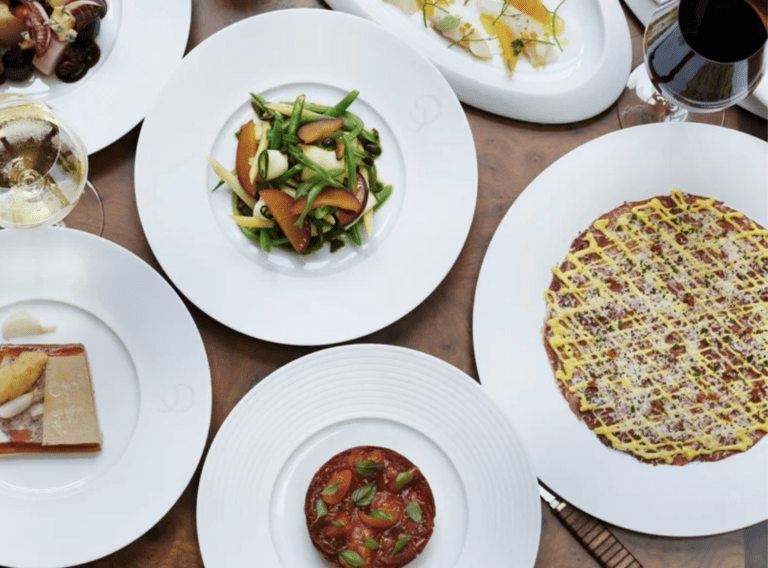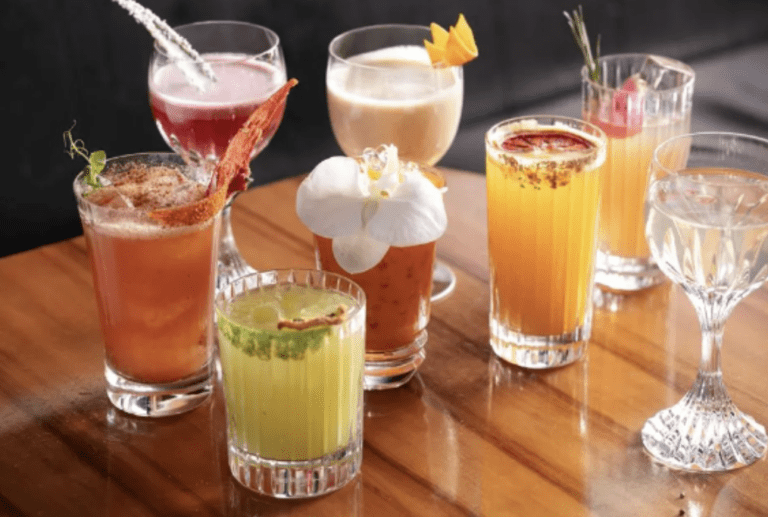How SH Hotels & Resorts Uses F&B to Become Dining Destinations
Sevenrooms
5 min read
Dec 19, 2023

Sevenrooms
5 min read
Dec 19, 2023

Not long after SH Hotels & Resorts opened 1 Hotel Mayfair, it was featured in Conde Nast Traveller as London’s first “mission-driven sustainable luxury hotel”. It makes sense; the property boasts nine stories of sustainable luxury in the heart of the iconic Mayfair district, and at every turn, guests are immersed in a stunning, environmentally-conscious nature scene that includes 1,300 plants, shrubs and trees.
The acclaim is high — especially the buzz around its hotel restaurant, Dovetale, which is backed by the two-Michelin-starred chef, Tom Sellers.
SH Hotels & Resorts focus on more energized foodservice concepts across its portfolio is purposeful, as more properties are turning to F&B to position themselves as a dining destination for tourists and locals alike. They have more than 25 F&B concepts that span 14 hotels, including Harriet’s, 1 Kitchen and more.
Lena Sotnick, Executive Director of F&B Marketing for SH Hotels & Resorts, tells us that the company views its food and beverage concepts as a critical element of the greater hotel ecosystem.
We talked with Lena to learn how SH Hotels & Resorts leverages innovative F&B to help its hotels stand alone as a dining destination:
In today’s competitive marketplace, hotels need to think beyond rooms and standard amenities. People want unique experiences. Research shows that nearly three out of four millennials would rather spend money on experiences than material goods; seven out of 10 want to attend food-focused events specifically.
To meet the needs of today’s consumer, hotels must leverage F&B concepts to deliver dining options that rival their rooms and become a space guests view as more than just a place to lay their heads.
SH Hotels & Resorts, whose concepts span from South Beach to China, has recognized the paradigm shift and responded accordingly. Lena says, “[Rooms and food and beverage] both equally hold the same weight. When planning F&B, we don’t want it to be ‘just an amenity to the hotel guest’ or ‘just a restaurant within a hotel.’ Our team of F&B operators really works hard to create special experiences for the hotel guests that are also unique to the community.”
Brands can prioritize accessibility, convenience and familiarity — baseline features guests expect from a hotel brand — without sacrificing elements the modern-day consumer craves: compelling, exclusive and authentic experiences. It doesn’t have to be just one or the other.
1 Hotel Mayfair is a perfect example of this dual-focused philosophy in action. The rooms match the brand’s standard of luxury, and F&B stands up to the innovative dining concepts found at free-standing restaurants in a city known for upscale Georgian elegance.
For example, the hotel’s cafe moonlights as a coworking space during the day and transforms into a stylish wine bar at night — this is both an amenity and an experiential destination. After a pre-dinner drink, guests can venture toward Dovetale, the venue’s highly acclaimed restaurant that focuses on local seasonal produce.
 Image source: 1 Hotel Mayfair, Dovetale
Image source: 1 Hotel Mayfair, Dovetale
Once upon a time, hotel restaurants catered exclusively to the guests sleeping in the bedrooms above them. Today, guests aren’t the only diners; locals visit these spaces with the same enthusiasm as any famous standalone location. These venues are more than just hotel restaurants; they’re restaurants inside hotels — hot spots with brand recognition that extends beyond the building in which they reside.
SH Hotels & Resorts has a few tips for creating authentic, memorable F&B experiences in all venues.
Image source: 1 Hotel Brooklyn Bridge, Harriet’s Rooftop
Lena urges venues to integrate with their local market and create restaurants that elevate the community — so much so that when travelers need recommendations, the locals are more than happy to sing your praises.
Establishing a communal presence in all their properties helped SH Hotels & Resorts build F&B spaces that serve an 80% local customer base.
“We often think, ‘How do we make this a beloved space by the local community as well as hotel guests?’ When I go to a new city, I reach out to friends and family in those cities and ask where they go out to eat or grab a cocktail. So, it’s really important we create special experiences that feel separate from just the hotel.”
When planning live music for Harriet’s rooftop entertainment, for example, the venue opts for a local professional instead of a retainer deejay who travels from city to city because they know the music scene varies at each location.
They use the same tailored approach when planning each establishment’s food and drink menus.
“As we look at our cocktail menus, we’ll always include our signature sustainable cocktails, but the rest of the menu is driven by the local community, the ingredients you can get there, and the different inspirations the beverage team takes from the community.”
Hotel restaurants hoping to pay homage to their community via F&B should establish loose guidelines to ensure brand consistency and then look to their surroundings to inform the rest.
As 1 Hotel’s 1 Kitchen restaurant concept likes to say, “The closer things are to home, the better they taste.”
An example of a tailored 1 Kitchen event page
Rarely does a standardized approach to experiential dining pan out. What works for a beachfront hotel restaurant in Miami won’t work for an upscale space in New York City. This means you must get creative from both an experience and marketing perspective.
When brainstorming event concepts, the SH Hotels & Resorts’ team of F&B operators develops special experiences according to the community.
“[We create] unique experiences that are true to us as a brand while also allowing the local properties the freedom to look at who’s doing what in their communities and how we can leverage that to create authentic local experiences,” says Lena.
Consider the culture, the demographics and the buyer personas of the people who reside in your area. Then, ensure your event marketing aligns with your brand and ideal customer base — this will differ according to the venue.
When SH Hotels & Resorts markets its events, the team incorporates a tone of voice and event page descriptions that align with its mission statement. For example, all events hosted by 1 Kitchen reinforce 1 Hotel’s sustainability efforts and commitment to supporting local farming that mitigates climate change. (Think: on-site farmer’s market pop-ups and quarterly mindful mixology masterclasses that allow guests to “indulge with intention” and “craft delicious sustainable sips” using locally sourced ingredients.)
Whether promoting hyper-customized masterclasses or simply highlighting live entertainment during brunch, it’s imperative to allow locals and guests to easily access and book these experiences.
Lena tells us that SH Hotels & Resorts recently transitioned from another event management marketplace to SevenRooms’ event management software. She credits the SevenRooms experience widget for helping the brand create a consolidated list of happenings so guests can quickly digest, view and book upcoming events.
Rooftop views of sleek cityscapes and blue ocean views are plentiful across the SH Hotels & Resorts portfolio, and Lena acknowledges that these attractions certainly help lure locals and tourists on-site. But you don’t need a view of the Brooklyn Bridge to draw a crowd. Attractions come in many shapes and forms — including F&B.
Whether you’re creating buzz for a grand opening (like 1 Hotel Mayfair) or attracting new and returning guests as an established venue, think of F&B as one of your most effective marketing strategies.
Lena says, “When we open in a new location, our marketing is definitely driven by the hotel and the food and beverage concepts within. But as you’re operating after opening, it’s really the F&B venues that play an important role in keeping those conversations going.”
Creating fun and unique events offers venues an unlimited supply of press opportunities. Baccarat Hotel New York is a well-established SH Hotels & Resorts property, but the team continually advertises its bi-annual cocktail story menu in the press. Its latest story menu is the Le Prism cocktail menu inspired by the sparkling surroundings of the hotel, which Forbes describes as a “celebration of light and each color in the rainbow.”
 Image source: Forbes
Image source: Forbes
Lena says that the company constantly leverages their F&B venues to promote its mission and stay top of mind when local communities host high-profile events like food and wine weeks. As you develop your own F&B concept, brainstorm how to include it in your marketing plans for greater exposure.
Finally, consider how F&B can serve another key demographic: tourists. Of course, there’s power in leveraging local diners to establish credibility and name recognition, but it’s equally important to nurture the tourist population who continually chooses your venue over another for their travel accommodations.
The modern traveler’s view of luxury extends beyond plush pillows and high thread-count sheets. They desire rich experiences at every touchpoint, including food, wellness and health, all encased in an authentic local environment. Many want all of this available to them in one location.
Lena credits SH Hotel’s commitment to F&B for making them more competitive in the tourist market and believes it’s a huge reason why tourists choose their hotels. Even better, their 360° approach to the guest experience helps keep guest spending on-site.
“Most of our venues are frequented by the local community, but the tourists are very much dining in our outlets. We don’t want to alienate anyone; we want to make sure that we’re creating a 360° destination for guests, ensuring they have everything they need if they don’t want to leave the property.” Lena continues, “We’ve created such brand loyalty and trust with our guests. They know that they’re not just going to have a great hotel room to stay in, but their additional F&B experiences, and spa experiences, are going to enhance their stay beyond just an everyday hotel experience.”
SH Hotels & Resorts proves that hotel restaurants have the potential to become dining destinations fueled by intentional food and beverage strategies. Done right, hotels can also be a place to hang out and eat great food.
When asked what she believes is the main factor in distinguishing a standard hotel restaurant from a dining destination, Lena doesn’t hesitate to share her secret to success.
“A venue that can accomplish something for all five senses is really what will set someone apart from the competition. When you can find a way to touch on all the senses, that’s when you create something really beautiful and magical that creates a very unique experience.”
Said another way, spaces that become a dining destination find a way to play with all of our senses through smell (food and drink), sounds (music), sight (views and ambiance) and touch (textures and comfort). The more you can stay true to your locale and differentiate, the better.
For more inspiration on how to turn your venues into profitable dining destinations, check out our guide to boosting revenue through F&B.